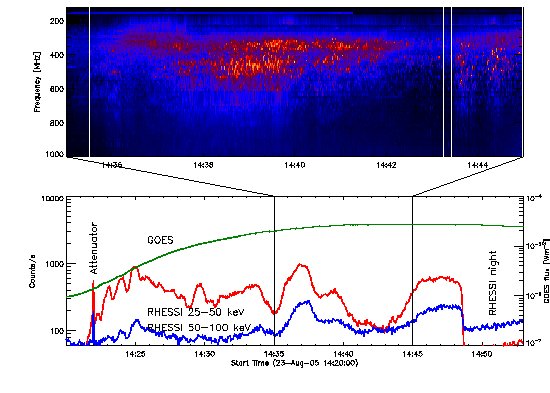Do solar decimetric spikes originate in coronal X-ray sources?
From RHESSI Wiki
Mbattaglia (Talk | contribs) (New page: == Introduction == In the standard solar flare scenario, a large number of particles (electrons and protons) are accelerated in the solar corona. Radiative signatures of those particles a...) |
Mbattaglia (Talk | contribs) |
||
| Line 1: | Line 1: | ||
| - | |||
== Introduction == | == Introduction == | ||
In the standard solar flare scenario, a large number of particles (electrons and protons) are accelerated in the solar corona. Radiative signatures of those particles are found in X-rays and radio wavelenghts, teling us the the particles are non-thermally distributed in energy. Assuming that the same distribution of particles causes both, X-ray and radio emission, one would expect a close relation of the two emission types. Indeed, millisecond spikes have been found to have a high temporal association rate with hard X-rays. | In the standard solar flare scenario, a large number of particles (electrons and protons) are accelerated in the solar corona. Radiative signatures of those particles are found in X-rays and radio wavelenghts, teling us the the particles are non-thermally distributed in energy. Assuming that the same distribution of particles causes both, X-ray and radio emission, one would expect a close relation of the two emission types. Indeed, millisecond spikes have been found to have a high temporal association rate with hard X-rays. | ||
| Line 9: | Line 8: | ||
By combining RHESSI observations (positions of X-ray sources) with Phoenix-2 data (identification of radio spikes) and observations from the Nancay Radio Heliograph (locations of the radio emission in 4 discrete frequencies) in a particularly well observed limb event we can find - at least one - answer to the above question. Figure one shows the radio spectrogram and the thermal and nonthermal X-ray light curves of the event. The spikes occured in the impulsive phase, when the soft X-ray emission was still rising. However, the radio emission is not clearly correlated with the details of the hard X-ray lightcurve. | By combining RHESSI observations (positions of X-ray sources) with Phoenix-2 data (identification of radio spikes) and observations from the Nancay Radio Heliograph (locations of the radio emission in 4 discrete frequencies) in a particularly well observed limb event we can find - at least one - answer to the above question. Figure one shows the radio spectrogram and the thermal and nonthermal X-ray light curves of the event. The spikes occured in the impulsive phase, when the soft X-ray emission was still rising. However, the radio emission is not clearly correlated with the details of the hard X-ray lightcurve. | ||
| + | [[Image:Mb_spikelcurve.jpg|650px|thumb|center|'''Figure 1''' (left): "Top": Phoenix-2 spectrogram. Narrowband radio spikes occurred during most of the displayed time, but two distinct intervals can be distinguished delimited by white vertical lines in the spectrogram. "Bottom": RHESSI light curves of nonthermal emission and GOES light curve of the 1-8 <math>\AA</math> band produced by thermal emission.]] | ||
| - | + | Now let us have a look at the spatial relations. | |
| - | + | ||
| - | + | ||
| - | + | ||
| + | [[Image:Mb_spikeposition.jpg|650px|thumb|center|'''Figure 2''' (left): The geometry observed for the two intervals defined in Fig. 1. RHESSI contours of the hard X-ray "coronal" sources at 18-22 keV are shown in <span style="color:#00BFFF"> light blue </span> and at 6-12 keV (thermal) in <span style="color:#FF0000"> red</span>. "Footpoint" sources at 25-50 keV are shown in <span style="color:#00008B"> dark blue</span> ]] | ||
'''Biographical Note:''' Arnold Benz is Professor at ETH Zurich, Switzerland. Marina Battaglia ist a post-doctoral research fellow at the University of Glasgow, Scotland. | '''Biographical Note:''' Arnold Benz is Professor at ETH Zurich, Switzerland. Marina Battaglia ist a post-doctoral research fellow at the University of Glasgow, Scotland. | ||
Revision as of 13:25, 8 June 2009
Introduction
In the standard solar flare scenario, a large number of particles (electrons and protons) are accelerated in the solar corona. Radiative signatures of those particles are found in X-rays and radio wavelenghts, teling us the the particles are non-thermally distributed in energy. Assuming that the same distribution of particles causes both, X-ray and radio emission, one would expect a close relation of the two emission types. Indeed, millisecond spikes have been found to have a high temporal association rate with hard X-rays.
But what about the spatial relations? Sticking to the picture of a coronal acceleration site one would expect coronal X-ray emission and radio spikes to originate from the same positions.
Observations
By combining RHESSI observations (positions of X-ray sources) with Phoenix-2 data (identification of radio spikes) and observations from the Nancay Radio Heliograph (locations of the radio emission in 4 discrete frequencies) in a particularly well observed limb event we can find - at least one - answer to the above question. Figure one shows the radio spectrogram and the thermal and nonthermal X-ray light curves of the event. The spikes occured in the impulsive phase, when the soft X-ray emission was still rising. However, the radio emission is not clearly correlated with the details of the hard X-ray lightcurve.

 band produced by thermal emission.
band produced by thermal emission.Now let us have a look at the spatial relations.
Biographical Note: Arnold Benz is Professor at ETH Zurich, Switzerland. Marina Battaglia ist a post-doctoral research fellow at the University of Glasgow, Scotland.
